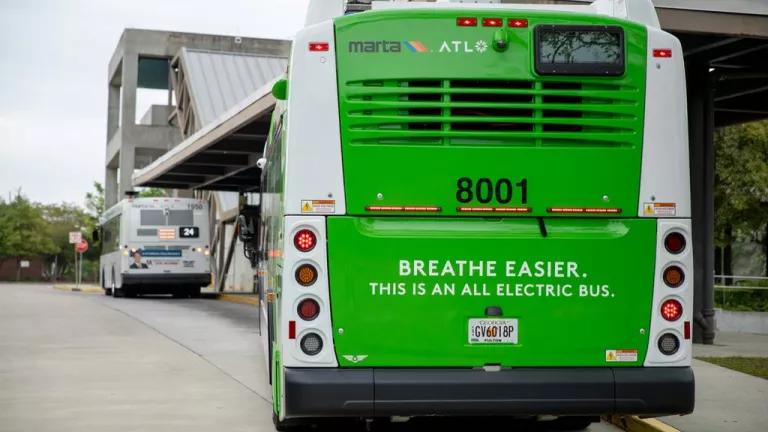Georgia is Number 1 for Business and Number 35 for Transportation
NRDC's recently published scorecard shows some of the progress being made in the state, but also highlights the significant work that remains to be done.

Georgia ranks 35th out of 50 in NRDC's new national report, which provides a snapshot of current state decisions on transportation-related policies and investments. The Scorecard ranks each U.S. state on a number of different metrics, including state planning, vehicle electrification, expanding mobility choices, among others aimed at identifying which states are advancing equity and climate outcomes in the transportation sector.
Despite its place in this year's rankings, Georgia is a leader in the South regarding its spending for road repair and maintenance. Proper road maintenance reduces wear and tear on vehicles and lowers their associated emissions. The state’s growing number of electric vehicle charging ports, both level 2 and fast charging, also improved its overall score.
Transportation is the largest source of greenhouse gas emissions in the United States, and the same is true of Georgia, where it makes up 40.5% of overall state emissions. Unlike many other states, Georgia has not yet adopted a statewide climate strategy, nor has it adopted greenhouse gas reduction targets as part of its transportation planning, project selection, or funding decisions.

Establish a Goal for Reducing Greenhouse Gas Emissions
There’s somewhat of a disconnect in Georgia as it relates to the green economy and climate change. The state has been one of the most successful in the country in attracting investments from clean energy companies, and since the passage of the Inflation Reduction Act, nearly 20 major new projects have been announced, totaling more than $12 billion in investments. This is at odds with the state’s lukewarm stance on climate change, of which the state’s Governor, Brian Kemp, says “he does not think about a lot.”
Georgia received a total of 0 points out of a possible 17 in the category of state planning. Unlike many other states, Georgia has not yet adopted a statewide climate strategy, nor has it adopted greenhouse gas reduction targets as part of its transportation planning, project selection, or funding decisions. Without a clear target or existing priorities, the state has no benchmark from which to measure success and a clear direction for its public agencies to focus their efforts.
Since 2021, the U.S. Department of Transportation has included equity in its strategic planning efforts and has also encouraged states to do the same. This is the first in a series of steps needed to remedy the harm that was inflicted primarily upon low-income communities of color through the construction of our country’s interstate system and subsequent inequities that are still present today. The Georgia Department of Transportation (GDOT) needs to do its part in addressing these historic harms while preventing future harm by incorporating equity as a metric to be used in the transportation project approval process. In practice, the agency would prioritize engaging equally with all users of its transportation system, with a particular focus on communities that have historically been underserved or excluded. This approach ensures these communities have a more significant influence on transportation decisions that directly impact their lives before the agency approves any projects or plans, which is a key method by which transportation equity can be achieved in state governments.
Provide Georgians with More Transportation Options
Georgia received a total of 9.4 points out of a possible 34 points in regards to expanding transportation options. Like most state departments of transportation, both historically and presently, GDOT continues to prioritize automobile travel over any other modes of transportation. Prioritizing individual vehicles leads to an ever-expanding interstate system that requires a constantly growing budget to maintain itself. Expanding interstates leads to induced demand, which perpetuates the cycle of ever-expanding interstates and congestion.

Induced demand follows the premise that if you make something easier for people to do – in this case, meaning in the short run, faster travel times due to increased interstate capacity – people will do more of it. Over time, more people shift their travel patterns instead of replacing a trip with public transit or waiting unitl after peak travel times which ultimately creates a cycle of ever-expanding interstates and congestion. Recent survey data shows that voters are well aware of this phenomenon, with the majority agreeing that "widening highways attracts more people to drive, which creates more traffic in the long run."
Atlanta is the largest metropolitan area in the Southeast and is home to about 57% of Georgia’s total population. The area is also home to the only heavy rail transit system, MARTA, in the South, and is the 8th largest rapid transit agency in the country. It is also the largest public transportation agency in the country in operation that has never received any state funds to support its operations. Given that, it comes as no surprise that Georgia received 0 out of a total of 5 possible points in the category of state dollars spent on transit per capita.
The Atlanta region is projected to gain an additional 2.9 million residents by 2050, bringing the metropolitan area's total population to 8.6 million. Given these projections and the sprawling nature of the area, now is the time to invest in alternate modes of travel, such as transit and safe biking facilities, which reduce congestion and lower emissions.
Bring Back The Clean Vehicle Tax Credit
Governor Brian Kemp has been pushing forward his agenda to make Georgia “the electric mobility capital of the world.” If we were to only measure this using the metrics of announced investments and jobs, it could be argued that the state is well on its way to global domination. That said, Georgia only received 3 out of a possible 31 points in the category for vehicle electrification. In order to boost this score and provide access to a greater number of Georgians, the state should bring back its Clean Vehicle Tax Credit.
Until July of 2015, Georgia had the second-highest number of electric vehicles on its roads and was the largest market for electric vehicles outside of California. This was made possible by a generous $5,000 rebate offered by the state for the purchase of a new electric vehicle. Bringing back this tax credit and including an additional carve-out for low-income buyers and used electric vehicles would provide greater access to the electric vehicle market for all Georgians. Access to this market is a key component to truly making Georgia the electric mobility capital of the country, and without these additional rebates, these vehicles – many of which will soon begin production in the state – will remain out of reach for most Georgians.
For many living in rural Georgia, public transit is simply not an option, and due to distinct characteristics of the rural landscape, making the switch to a private electric vehicle provides a much more effective use case than in urban areas. These characteristics include longer travel distances to amenities and a relatively higher share of households who own their homes, both of which highlight the cost savings due to electric vehicles being cheaper to operate than internal combustion vehicles, and easier access to charging these vehicles at home.
—
Want to take action on clean transportation? Urge your governor to embrace and enact our recommendations through their Department of Transportation!



